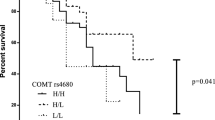Abstract
Objective
To evaluate the impact of the DRD2 TaqIA and DRD3 Ser9Gly polymorphisms on the efficacy of pramipexole in treating patients with Parkinson’s disease (PD).
Methods
Thirty patients with PD prospectively received pramipexole 0.25 mg three times daily for 2 months. Unified Parkinson Disease Rating Scale (UPDRS) assessments were conducted at baseline and 2 months after treatment initiation. Improvement by 20% or more in the total score on the UPDRS was considered to indicate responsiveness. The PCR–restriction fragment length polymorphism analysis was used to analyze the DRD2 Taq1A and DRD3 Ser9Gly genotype.
Results
The DRD2 Taq1A allele frequencies were A141.7 (A1) and 58.3% (A2), and the DRD3 Ser9Gly allele frequencies were 68.3 (Ser) and 31.7% (Gly). When the subjects were grouped by the DRD3 Ser9Gly polymorphism, the response rates for pramipexole treatment were significantly higher in the Ser/Ser group (60%) than in the group containing the Gly allele (13%). There was a significant association between the DRD3 Ser9Gly polymorphism and response rate to pramipexole in PD patients (P = 0.024). When the subjects were grouped by the DRD2 Taq1A polymorphism, there were no significant differences among the three Taq1A genotypes.
Conclusions
DRD3 Ser9Gly polymorphisms are significantly associated with the therapeutic efficacy of pramipexole in Chinese patients with PD. A large-scale and multi-dose group study in patients with PD is necessary for evaluating the impact of the genetic polymorphisms of the dopamine receptor on the therapeutic effects of pramipexole.
Similar content being viewed by others
References
Clarke CE, Guttman M (2002) Dopamine agonist monotherapy in Parkinson’s disease. Lancet 360(9347):1767–1769
Sokoloff P, Giros B, Martres MP et al (1990) Molecular cloning and characterization of a novel dopamine receptor (D-3) as a target for neuroleptics. Nature 347:146–151
Lannfelt L, Sokoloff P, Martres MP et al (1992) Amino acid substitution of the dopamine D3 receptor as a useful polymorphism for investigating psychiatric disorders. Psychiatr Genet 2:249–256
Lundstrom K, Turpin MP (1996) Proposed schizophrenia-related gene polymorphism: expression of the Ser/Gly mutant human dopamine D3 receptor with the Semliki Forest virus system. Biochem Biophys Res Commun 225:1068–1072
Jönsson EG, Nöthen MM, Grünhage F et al (1999) Polymorphisms in the dopamine D2 receptor gene and their relationships to striatal dopamine receptor density of healthy volunteers. Mol Psychiatry 4(3):290–296
Wang J, Liu ZL, Chen B et al (2001) Association study of dopamine D2, D3 receptor gene polymorphisms with motor fluctuations in PD. Neurology 56(12):1757–1759
Aklillu E, Kalow W, Endrenyi L et al (2007) CYP2D6 and DRD2 genes differentially impact pharmacodynamic sensitivity and time course of prolactin response to perphenazine. Pharmacogenet Genomics 17(11):989–993
Retz W, Rösler M, Supprian T et al (2003) Dopamine D3 receptor gene polymorphism and violent behavior: relation to impulsiveness and ADHD-related psychopathology. J Neural Transm 110(5):561–572
Reilly DK, Rivera-Calimlim L, Van-Dyke D (1980) Catechol-O-methyltransferase activity: a determinant of levodopa response. Clin Pharmacol The 28(2):278–286
Rivera-Calimlim L, Reilly DK (1984) Difference in erythrocyte catechol-O-methyltransferase activity between Orientals and Caucasians: difference in levodopa tolerance. Clin Pharmacol The 35(6):804–809
Lee MS, Lyoo CH, Ulmanen I et al (2001) Genotypes of catechol-O-methyltransferase and response to levodopa treatment in patients with Parkinson’s disease. Neurosci Lett 298(2):131–134
Chong DJ, Suchowersky O, Szumlanski C et al (2000) The relationship between COMT genotype and the clinical effectiveness of tolcapone, a COMT inhibitor, in patients with Parkinson’s disease. Clin Neuropharmacol 23(3):143–148
Białecka M, Droździk M, Kłodowska-Duda G et al (2004) The effect of monoamine oxidase B (MAOB) and catechol-O-methyltransferase (COMT) polymorphisms on levodopa therapy in patients with sporadic Parkinson’s disease. Acta Neurol Scand 110(4):260–266
Contin M, Martinelli P, Mochi M et al (2004) Dopamine transporter gene polymorphism, spect imaging, and levodopa response in patients with Parkinson disease. Clin Neuropharmacol 27(3):111–115
Skipper L, Liu JJ, Tan EK (2006) Polymorphisms in candidate genes: implications for the current treatment of Parkinson’s disease. Expert Opin Pharmacother 7(7):849–855
Arbouw ME, van Vugt JP, Egberts TC (2007) Pharmacogenetics of antiparkinsonian drug treatment: a systematic review. Pharmacogenomics 8(2):159–176
Neville MJ, Johnstone EC, Walton RT (2004) Identification and characterization of ANKK1: a novel kinase gene closely linked to DRD2 on chromosome band 11q23.1. Hum Mutat 23(6):540–545
Accili D, Fishburn CS, Drago J, Steiner H, Lachowicz JE, Park BH, Gauda EB, Lee EJ, Cool MH, Sibley DR, Gerfen CR, Westphal H, Fuchs S (1996 Mar 5) A targeted mutation of the D3 dopamine receptor gene is associated with hyperactivity in mice. Proc Natl Acad Sci USA 93(5):1945–1949
Acknowledgments
This work was supported by research grants from the National Natural Science Foundation of China 30600774, 30300428, 30672497 30500623, and 30472054 and by the China Medical Board of New York grants 01-755.
Author information
Authors and Affiliations
Corresponding author
Rights and permissions
About this article
Cite this article
Liu, YZ., Tang, BS., Yan, XX. et al. Association of the DRD2 and DRD3 polymorphisms with response to pramipexole in Parkinson’s disease patients. Eur J Clin Pharmacol 65, 679–683 (2009). https://doi.org/10.1007/s00228-009-0658-z
Received:
Accepted:
Published:
Issue Date:
DOI: https://doi.org/10.1007/s00228-009-0658-z




